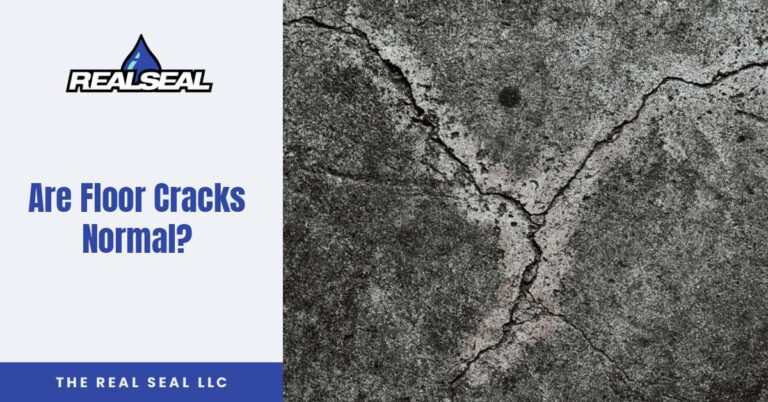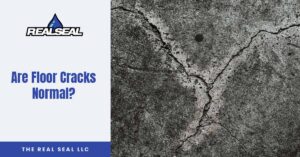Very often, when you are purchasing a home for the first time, you will come across Floor Cracks in the basement and think to yourself, are these floor cracks normal? How do I fix floor cracks? Should I be worried? These are perfectly normal questions and worries to have when buying a home or discovering more of your current home.
How to tell if your floor crack is normal
Floor cracks occur for a few different reasons, but hinge on the point that this is a large and thin concrete slap (thin compared to how wide and long it is). As a result, as dirt settles and compresses under your home, the concrete will settle with it. The cracks form at the stress points. For most cases, this is completely normal and requires no repair. Below is a list of things to check on your floor cracks to see if they need attention:
- The concrete on both sides of the crack is even.
- Great! This means that there has been no major settling or heaving (more on heaving soon)
- There is no water coming up from the crack.
- Even better! When we have no water coming from the floor cracks, we are more assured that there is not something to fix.
- There is no radon issues in the home.
- With no radon issues, there is no need to seal cracks to prevent air from coming up.
How to tell if your floor crack is NOT normal and needs repair
When everything is perfect, everything is perfect. But what if one of the concerns above IS an issue? What is causing the floor crack issue and how do we solve it? Because floor cracks can form in other ways and cause other issues, it is important we discuss them here. Below is the same list as above, but this time these are issues:
- The concrete on both sides is NOT even.
- Two things could be going on here. The first is called “Heaving.” This happens when excess water pressure under the floor pushes the floor up, causing a hump. Heaving is difficult because we cannot lower concrete. This will require removal and replacement of the concrete floor.
- The second thing that could be happening is excess settlement. This can be in conjunction with the foundation settlement that may be present, or it could be interior from dirt settlement or washout.
- Excess settlement needs to be addressed with piers around the foundation and Polyjacking under the floor. What Polyjacking entails is injecting an expanding foam under the floor to raise it up. We can get the floor back to near even with this technique.
- “Washout” can happen with excess water flow from gutters/grading/etc OR from sewer breaks. The washout from gutters is fairly easy, move the gutters and adjust the grading to lessen the water flow. Sewer lines require dig and repair. The broken sewer line takes dirt and washes it away, causing a void that the concrete floor settles into.
- There IS water coming up from the floor crack
- As we can guess, water in the basement is not a good thing. We will need to install an Interior Drain Tile System in order to stop this seepage. This will entail a 4” pipe being buried underneath the floor to “guide” water to a Sump Pit, where it is then discharged from the home.
- Radon Gas IS present
- If you have had a Radon test and know that you have Radon Gas coming up from the basement floor, you will want to get these cracks sealed. For this application, as long as the other above issues are not present, you will simply need to caulk those cracks to prevent the air from getting through. Furthermore, if you have not installed a Radon Mitigation System, you will need to at this point as well.
Learn more about – Why Poly-Jacking Is Better Than Mudjacking?
How to Fix Cracks in a Basement Floor
The chosen repair method for fixing a crack in a basement floor depends on what caused the crack. Here are a few possible repair solutions:
- Fixing a crack caused by heaving – These cracks usually mean the concrete floor needs to be replaced.
- Fixing a floor crack caused by settlement – Common repair solutions here are underpinning using piers and polyjacking under the floor.
- Fixing a floor crack when there’s water coming through it – This will most likely require installing a drain tile system.
But the Salesman that came out said I NEEDED a Drain Tile
Beware, beware the pressure salesman. If you do not know what this is, go watch the movie Glengarry Glen Ross. They will NEVER say they are pressure salesman, but they will lie and cheat to get you to install a system that is not necessary. Be sure to check online for reviews and get multiple quotes so you do not get “sold” by a charming salesman that disappears the moment they leave the home.
***Just because you have floor cracks does NOT mean you need a Drain Tile.***
Print the above statement out and have ready for any salesman that comes to your home. Protect yourself and do not allow yourself to be cheated. While it may be necessary for a Drain Tile if you are experiencing seepage, we have had many of our customers report that they were being pushed, HARD, to do a Drain Tile when we determined it was not necessary or even practical. DO YOUR RESEARCH!
Thanks for reading, and as always:
“Not Everything’s Better When Wet”







2 Responses
Hi Austin, thanks for your info! I am a new employee involved in construction, and in addition to pouring concrete blocks and asphalt repairs, we do basement leaks/ sump pump repair and installation. It’s nice to have a good point of reference for future projects. Thanks so much!
Happy to help, Chris!